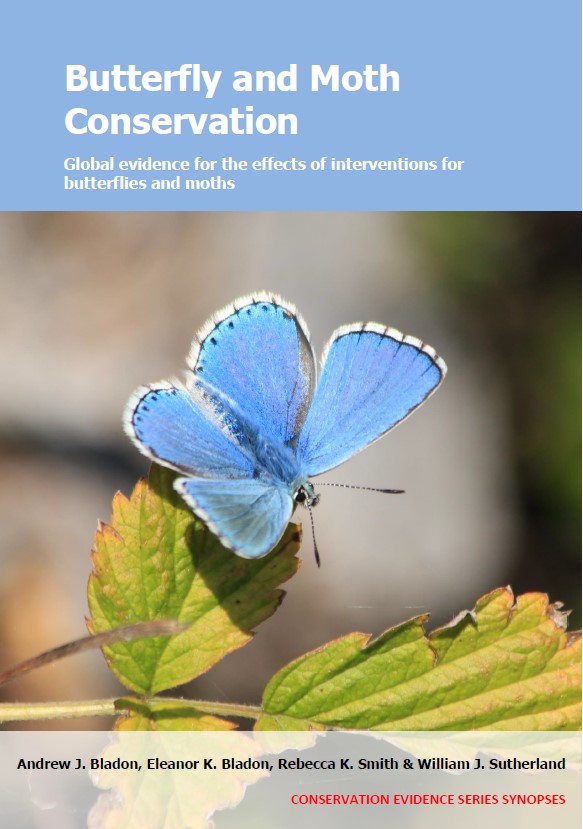Actions to conserve biodiversity
We have summarised evidence from the scientific literature about the effects of actions to conserve wildlife and ecosystems.
Review the evidence from the studies
Not sure what Actions are? Read a brief description.
Search for evidence
e.g. "frogs chytrid"
152 Actions found
Refine
Hide
152 Actions found
Download Actions
| 0 selected |
|
Order results by:
| Action | Effectiveness | Studies | Category | |
|---|---|---|---|---|
|
Protect or restore brownfield or ex-industrial sites Action Link |
No evidence found (no assessment) | 0 |
|
|
|
Provide buffer strips to reduce pesticide and nutrient run-off into margins, waterways and ponds Action Link |
Awaiting assessment | 1 |
|
|
|
Provide or retain set‐aside areas in farmland Action Link |
Awaiting assessment | 9 |
|
|
|
Provide shelter habitat against highly adverse weather conditions Action Link |
No evidence found (no assessment) | 0 |
|
|
|
Provide training for land managers, farmers and farm advisers Action Link |
Evidence not assessed | 1 |
|
|
|
Raise awareness amongst the general public to promote conservation actions Action Link |
No evidence found (no assessment) | 0 |
|
|
|
Raise cutting height on grasslands Action Link |
Awaiting assessment | 2 |
|
|
|
Re-plant native trees in logged areas Action Link |
Evidence not assessed | 1 |
|
|
|
Rear declining species in captivity Action Link |
Evidence not assessed | 22 |
|
|
|
Reduce cutting frequency on grassland Action Link |
Awaiting assessment | 6 |
|
|
|
Reduce fertilizer, pesticide or herbicide use generally Action Link |
Evidence not assessed | 11 |
|
|
|
Reduce field size (or maintain small fields) Action Link |
Awaiting assessment | 5 |
|
|
|
Reduce grazing intensity on grassland by reducing stocking density Action Link |
Evidence not assessed | 14 |
|
|
|
Reduce grazing intensity on grassland by seasonal removal of livestock Action Link |
Awaiting assessment | 7 |
|
|
|
Reduce management intensity on permanent grasslands (several interventions at once) Action Link |
Awaiting assessment | 12 |
|
|
|
Reduce planting density to create warmer woodlands Action Link |
No evidence found (no assessment) | 0 |
|
|
|
Reduce the size of surface features when prospecting for or extracting underground products Action Link |
Awaiting assessment | 1 |
|
|
|
Reintroduce mammals as ecosystem engineers Action Link |
Awaiting assessment | 1 |
|
|
|
Release captive-bred individuals to the wild Action Link |
Evidence not assessed | 13 |
|
|
|
Remove or change turbine lighting to reduce insect attraction Action Link |
No evidence found (no assessment) | 0 |
|
|
|
Remove or control non-native or problematic plants Action Link |
Evidence not assessed | 9 |
|
|
|
Remove or control non-native predators Action Link |
No evidence found (no assessment) | 0 |
|
|
|
Remove tree canopy to reduce pond or waterway shading Action Link |
Awaiting assessment | 1 |
|
|
|
Remove, control or exclude invertebrate herbivores Action Link |
Evidence not assessed | 1 |
|
|
|
Remove, control or exclude native predators Action Link |
Evidence not assessed | 5 |
|
Download Actions
| 0 selected |
|

Butterfly and Moth Conservation - Published 2023
Butterfly and Moth Synopsis
Watch this search
If you are familiar with RSS feeds, please click the button below to retrieve the feed URL:
RSS feed for this searchIf you are unfamiliar with RSS feeds, we would suggest reading this BBC article.
Unfortunately, due to the number of feeds we have available, we cannot provide e-mail updates. However, you could use tools such as Feed My Inbox to do this for you.
What are 'Individual studies' and 'Actions'?
Individual studies
An individual study is a summary of a specific scientific study, usually taken from a scientific journal, but also from other resources such as reports. It tells you the background context, the action(s) taken and their consequences.
If you want more detail please look at the original reference.
Actions
Each action page focuses on a particular action you could take to benefit wildlife or ecosystems.
It contains brief (150-200 word) descriptions of relevant studies (context, action(s) taken and their consequences) and one or more key messages.
Key messages show the extent and main conclusions of the available evidence. Using links within key messages, you can look at the paragraphs describing each study to get more detail. Each paragraph allows you to assess the quality of the evidence and how relevant it is to your situation.
Where we found no evidence, we have been unable to assess whether or not an intervention is effective or has any harmful impacts.





)_2023.JPG)














